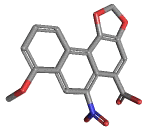|
ARISTOLOCHIC ACID I |
| Synonyms. Aristolochic acid; Tardolyt; Aristolochine; Aristolochic acid I; 3,4-Methylenedioxy- 8-methoxy-10-nitro-1-phenanthrenecarboxylic acid; 8-Methoxy-3,4-methylendioxxy-10-nitro-1- phenanthrencarbonsaeure; 8-Methoxy-6-nitrophenanthol (3,4-d) 1,3-dioxole-5-carboxylic acid; Aristolochiazaeure; 8-Methoxy-6-nitrophenanthro(3,4-d)-1,3-dioxole-5-carboxylic acid; Aristinic acid; Aristolochia yellow; Aristolochic acid A; |
| PRODUCT IDENTIFICATION | |
|
CAS RN |
313-67-7 |
|
EINECS RN |
206-238-3 |
|
FORMULA |
C17H11NO7 |
|
MOLE WEIGHT |
341.27 |
|
H.S CODE |
2932.99.6100 |
|
SMILES |
[O-][N+](=O)c1cc4c(c2c1c(C(=O)O)cc3OCOc23)cccc4OC |
|
CLASSIFICATION |
Anti-Infective, Alkaloid |
|
EXTRA NOTES |
Phospholipase A inhibitor. |
|
|
| PHYSICAL AND CHEMICAL PROPERTIES | |
|
PHYSICAL STATE. |
white to off-white powder |
|
MELTING POINT |
269 ~ 270 C |
|
BOILING POINT |
|
|
DENSITY |
|
|
SOLUBILITY IN WATER |
Slightly soluble |
| SOLVENT SOLUBILITY |
Soluble in alcohol, chloroform, ether, acetone, acetic acid, aniline, alkalies. Practically insoluble in benzene, carbon disulfide |
|
VAPOR DENSITY |
|
|
log P(octanol-water) |
|
|
VAPOR PRESSURE |
|
|
AUTOIGNITION TEMP |
|
| pK |
|
|
REFRACTIVE INDEX |
|
|
FLASH POINT |
|
|
|
| STABILITY AND REACTIVITY | |
| STABILITY | Stable under normal conditions. |
|
INCOMPATIBLE MATERIALS |
Strong oxidizing agents |
| POLYMERIZATION |
Has not been reported |
|
NFPA RATINGS |
Health: 2, Flammability: 0, Reactivity: 0 |
|
|
| EXTERNAL LINKS & GENERAL DESCRIPTION |
|
USA.gov - Aristolochic acid Wikipedia Linking - Aristolochic acid Google Scholar Search - Aristolochic acid U.S. National Library of Medicine - Aristolochic acid PubChem Compound Summary - Aristolochic acid Drug Bank - Aristolochic acid KEGG (Kyoto Encyclopedia of Genes and Genomes) - Aristolochic acid ChEBI (http://www.ebi.ac.uk/chebi/) - Aristolochic acid NCBI (http://www.ncbi.nlm.nih.gov/) - Aristolochic acid |
|
|
| SALES SPECIFICATION | |
|
APPEARANCE |
white to off-white powder |
|
ASSAY |
98% min |
|
MELTING POINT |
269 ~ 270 C |
|
LOSS ON DRYING |
0.5% max |
|
|
| TRANSPORT & REGULATORY INFORMATION | |
|
UN NO. |
1544 |
| HAZARD CLASS |
6.1 |
| PACKING GROUP | III |
|
|
| SAFETY INFORMATION | |
|
HAZARD OVERVIEW |
Warning! Cancer suspect agent. May cause kidney damage. Harmful if swallowed, inhaled, or absorbed through the skin. Causes eye, skin, and respiratory tract irritation. Target Organs: Kidneys, respiratory system, eyes, skin. Potential Health Effects Eye: Causes eye irritation. Skin: Causes skin irritation. Harmful if absorbed through the skin. Ingestion: Harmful if swallowed. May cause irritation of the digestive tract. May cause kidney damage. Inhalation: Harmful if inhaled. Causes respiratory tract irritation. Chronic: Prolonged or repeated skin contact may cause dermatitis. May cause kidney damage. |
| SIGNAL WORD | Danger |
|
PICTOGRAMS |
|
|
HAZARD STATEMENTS |
H350: May cause cancer |
|
PRECAUTIONARY STATEMENTS |
P301 + P310:IF SWALLOWED: Immediately call a POISON CENTER or doctor/physician |
| EC DIRECTIVES |
|
| HAZARD CODES |
|
|
RISK PHRASES |
R 45 May cause cancer. |
|
SAFETY PHRASES |
S 53 Avoid exposure - obtain special instructions before use. |
|
|
| PACKING |
|
Preserve in light-resistant and well-closed containers |
|
|
| PRICE INFORMATION |
|
|


